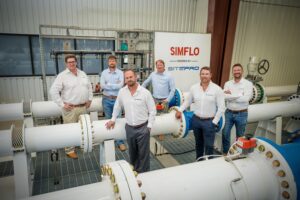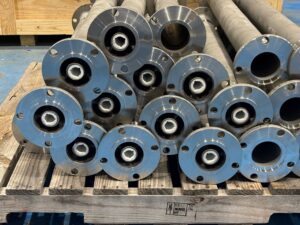New Elephant House at the Cologne Zoo – Software helps to size the pumps
The oldest existing building at the Cologne Zoo is the Elephant House, a Moorish design constructed in 1863. In order to respond to the latest knowledge of the needs of these animals, an architecture competition was announced in 1999 which has resulted in a project to erect a new Elephant House. The layout of the pumping systems for water drainage in the facility was conceived by ACO Passavant Gebäudeentwässerung GmbH (Phillipsthal). To determine the various duty points (head and capacity) and to select the appropriate pumps, Spaix® PipeCalc and Spaix® Classic pipe calculation software from VSX – VOGEL SOFTWARE was employed.
The objectives for the new Elephant House at the Cologne Zoo were as follows. Various pump sumps are required, for two waterfalls among other requirements. The pumping capacity must be adjusted precisely to the duty point (with throttling provided by orifice plates or gate valves). The submersible pumps used must be constantly underwater, since the pumps run approx. 12 hours per day. The other pump sumps are intended for the reservoirs in the enclosure. These pumps have to run approximately once a year to drain the reservoirs. During the draining phase the pumps will run continuously for around 36 hours. Here again the inlet quantity and the pump capacity have to be brought into agreement, so that the pumps can remain constantly underwater to ensure sufficient cooling while they are pumping.
„The Spaix® system of programs was very helpful to us in calculating and in selecting the appropriate pumps, which we calibrated for the optimum duty point by trimming the impellers. The user interface is self-explanatory and easy to use. Using this system of programs saved us considerable time compared with the usual calculation methods”, according to Manfred Schäfer of ACO Passavant, who oversaw the project.
To represent all the pump sumps, Waterfall 1 can be used as an example for duty point determination. A submersible pump continuously circulates the water. The flow rate is given by the flow speed and water amount of the waterfall, namely 61.2 m3/h. The resulting head is determined using Spaix® PipeCalc. First the type of medium needs to be defined. Domestic wastewater with no fecal content comes closest to the actual medium. The total flow of 61.2 m3/h is entered and the desired number of pumps defined as “1”. The geodesic head, which at 6 m corresponds approximately to the height of the waterfall, also enters the calculation. To determine the loss of each component in the piping system, you must specify the material, the nominal width, the pipe length and the pipe roughness. The pipe systems consists of 10 m of straight pipe length and 4 elbows, both cast iron and DN 100, an expander from 80 to 100 mm, a DN 80 slide valve and a DN 80 check valve. The loss is calculated for each individual component and the resulting total head loss determined from this, which in our case is 3.7 m. The geodesic head and friction loss result then in a total head loss of 9.7 m. The next step is to select the hydraulically optimized pump for our application. The determined operating point of H = 9.7 m and Q = 61.2 m3/h is entered directly into the Spaix® pump selection software, which contains the hydraulic and technical product data for ACO Passavant’s pump and lift equipment. Using the specified duty point, the program searches the pump database for the appropriate hydraulics. The software suggests the SAT-Q 400/80/D as the optimum pump. Given Q = 62.3 m3/h and H = 9.8 m, the operating point of the pump agrees very precisely with the specification. In addition to the pump diagram, the program supplies all the other information and technical details about the product, such as various installation drawings, the tender text, materials, photo, etc. This makes it very easy to document the project. Finally, the complete quotation documents can be printed out on prepared data sheets.
Spaix® PipeCalc is the leading program for duty point calculation of centrifugal pumps in the field of drainage and domestic utilities. It allows determination of the required pumping capacity for selected applications according to international standards as well as the calculation of pipeline losses. Spaix® PipeCalc determines flow rate and quantity for drainage systems for example according to EN 12056 and ATV 118 and for drinking water supply systems according to DIN 1988.
To calculate pipeline losses, both unbranched pipeline systems and branched systems with identical, parallel branches are allowed for. When the flow is known, the friczion loss of the pipeline system and thereby the required head for the pump are determined according to the pipeline loss components from straight pipe lengths, fittings, shaped parts and exit loss. The calculation can be done according to the COLEBROOK or HAZEN WILLIAMS models.
The calculated results are summarized for clarity on data sheets and can also be directly loaded into a pump selection program for further processing.
Source: VSX – VOGEL SOFTWARE GmbH







